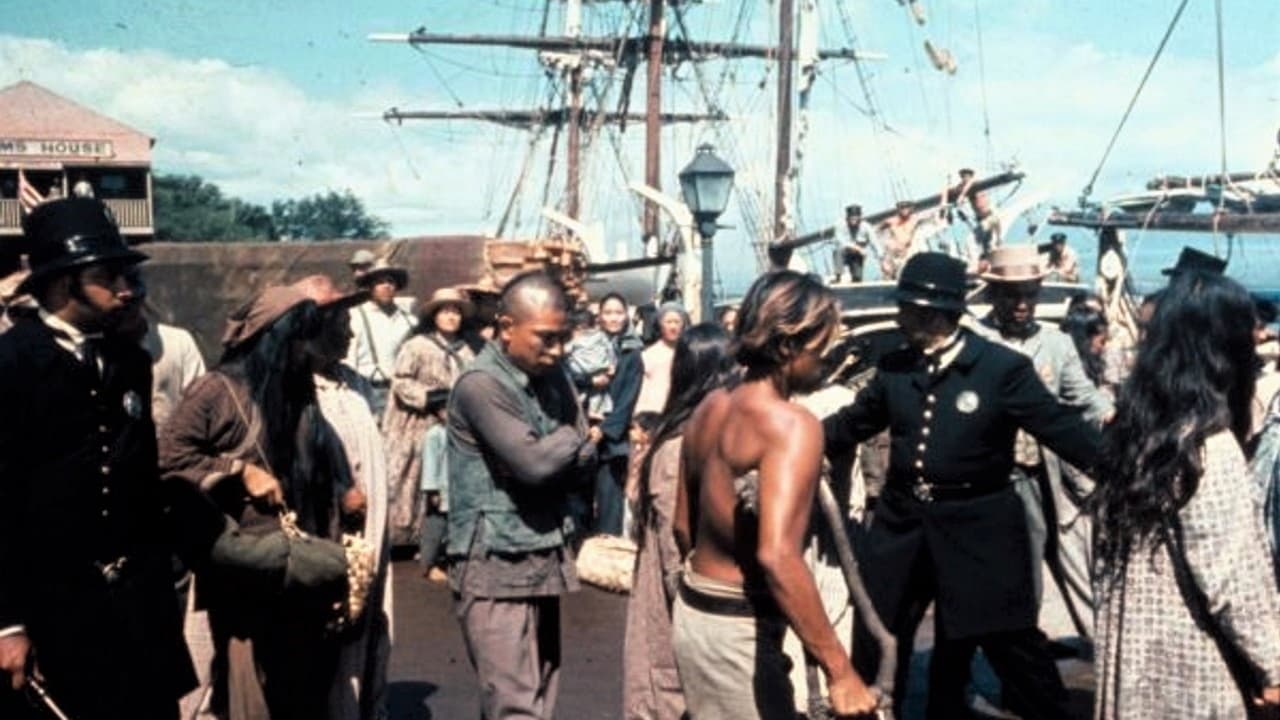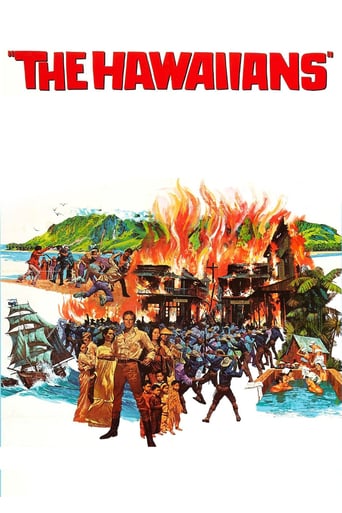

Based on the James Michener novel Hawaii, this sequel (to Hawaii (1966)) received a Best Costume Design Oscar nomination. It follows the life of 'Whip' Hoxworth, played by Charlton Heston, and those he comes in contact with through many years on the islands before they became our 50th state, including the introduction of the telephone and early automobile. Directed by Tom Gries with a screenplay by James R. Webb, it features breathtaking views of land and sea, including those of sea-worthy sailing ships.It begins with Whip captaining a ship transporting Chinese workers to the islands for cheap labor. One of these is Mun Ki (Mako), who saves a woman Char Nyuk Tsin (Tina Chen) from being sold into prostitution by claiming she's his wife, when they arrive. Whip hires them as cook & servant and takes them to his luxurious home where he's reunited with his wife Purity (Geraldine Chaplin). I haven't read the book, but I will say that the film skips forward, 2-3 years at a time or more, many times as the story takes place over several decades.The first "segment" of the film establishes the relationships between the two "man and wife" combinations. Mun Ki is in fact already married to a woman in China and, as the resident Chinese Wise Man/Lawmaker Foo Sen (Keye Luke) explains to Char Nyuk Tsin, all the children she bears for him will be regarded as his wife's, whereas she will be known to them as their "auntie". However, there relationship is one of true love, he teaching her how to speak pigeon English since their native Chinese dialects are incompatible. Chen gives the performance of the film, one which inexplicably went unrecognized by the Academy in what was, IMO, a weak year for Best Actresses (e.g. given those that were nominated). She accepts her role, and eventually gives birth to four sons (instead of the five he'd wanted, named for each continent per Foo Sen) and one daughter. Her character is also transformed from one which she herself initially claims is "not smart", relative to her "husband", to a very strong (even progressive) female & minority role model, businesswoman, and leader. During this time, she demonstrates her deep commitment to Mun Ki by choosing to go with him to the leper colony, with no hope of return, on Molokai when he contracts the disease.Whip is married to a one-fourth native Hawaiian who, after bearing him a son herself, becomes withdrawn and eventually somewhat crazy as she immerses herself in the "dying" native culture, and ultimately leaves him. He is shocked to learn when he returns from the sea that his grandfather, and benefactor, has died and left him nothing but thousands of seemingly useless acres of land in lieu of the command of the family shipping fleet he covets. His wealthy missionary family, led by his cousin Micah (Alec McCowan), has control of the assets and offer to give him "his" ship if the "black sheep of the family" would leave and never return. He refuses, and hires a drunkard well digger (Don Knight) who finally finds fresh water on the property which enables Whip to eventually become a rich pineapple plantation owner.Whip becomes a man who believes he can do anything he wants, which he does by taking bigger and bolder risks throughout the story. He takes his son Noel back from his estranged wife, and "raises" him until the 15 year old departs for his "real" education on the sea, just like his father did. Whip commits several illegal acts, including ones which enable him to introduce pineapple growing to the islands.Noel is played by various different actors as he ages but only really figures prominently in the film's last, and weakest part (when John Phillip Law plays the role). Separated from his wife for years, Whip also sets up a Japanese concubine (Miko Mayama). The last part of the film is more about the political evolution of the island (involving Whip, Micah and Queen Liliuokalani, played by Naomi Stevens) towards annexation by the U.S., and isn't nearly as compelling as the first 90 minutes. It also includes a too contrived romance for Noel upon his return.
... View MoreJames Mitchner's books on the south seas and the people living there are always fascinating reading. Any one of his novels can easily fit onto the silver screen. This particular film, " The Hawaiians " is a case in point. Following the exploits of the main character who draws the most attention, Charlton Heston plays Whip Hoxworth, an experienced sea Captain who dreams of overseeing a scheduled line of commercial vessels. His force of acting brings the worthy sea Captain ashore to confront the religious power of his clan. Having enough of the high Seas, Whip decides to stay shore-bound and tend to his Grandfater's sailing ships. Unfortunately, he arrives too late as his Grandfather left all his businesses to his laboriously pious and financially selfish family, leaving him an unpromising island called Hanni-Ki. Disappointed, he begins to despair his future when Milton Overpeck, a drunken driller (Don Knight) offers him an opportunity to become rich. At nearly the same time an oriental pair Tina Chen (Nyuk Tsin) and Mun Ki (Kako) arrive in Hawii and during the ensuing years, join Hoxworth in the ever changing social and political landscape. Geraldine Chaplin plays Purity Hoxworth a woman who slowly loses her mind, her son and her husband. John Phillip Law, Alec McCowen and Keye Luke add to the star studded film. With the magnificent Hawiian landscape as a backdrop, this movie is a splendid example of art come to life. The story is solid as is the acting with the result being a Classic created from a literary novel. ****
... View MoreThis film today, is quite forgotten because it never turns up on TV and is not widely available on video, and certainly not yet on DVD. Tis is a great pity as THE HAWAIIANS is an excellent and interesting stand alone sequel to the whopper epic of 1966 HAWAII - which was a 70mm release with Julie Andrews and Max Von Sydow (and even Bette Milder in a crowd scene). James Mitchener and his tales of the south seas books presented film makers with many opportunities for grand and spectacular South Pacific extravaganza dramas and even one enchanted musical. THE HAWAIIANS is basically the story of how Charlton Heston started the pineapple industry in Hawaii, with the help of hard working clever Chinese peasants, some of whom were brought into the plantation household for love and 'marriage' and even unfortunately, a spot of leprosy. While that might sound trite, and I am not making fun of it, it allows for 'ordinary' people to feature center screen in an epic way. Because this film is not about "major Euro characters" like in the first film, THE HAWAIIANS unjustly has been derailed and forgotten. But it is actually more interesting because it is about someone else other than religious zealots smashing idols and their sexually repressed wives ripping the corset off to run barefoot down the beach with the native teenagers.. So if you wish to see a truly glorious epic film about the people who actually did something to and for Hawaii (whether it ultimately good or bad) THE HAWAIIANS lives up to its title showcasing the real hard working people who lived and loved in Hawaii a century ago. I had the unforgettable experience of seeing both HAWAII and THE HAWAIIANS back to back as a double feature (7pm-midnight) in a Sydney Suburban cinema one freezing winter night lashed by a monster cyclonic thunderstorm. Here we were rugged to the chin in woolly everything straining to hear the soundtrack over the crashing din of the rain on the theater's enormous tin roof whilst looking at a spectacular cinema-scope vista of tropical sunny island drama. About an hour into the first film, the plaster ceiling sprang several serious leaks and a very grimy waterfall left of screen that was washing 55 years of dirt from above the curtains. The tubby manager and the broom kid were heard scurrying into the ceiling with empty tin ice cream bins. With hissed directions from Mr Tubby, the kid was clomping about on the beams, creaking and thudding, placing empty tins under the drizzle from the roof above. That plugged the leaks but instead started a hilarious symphony of 'pling' and 'plong' and 'plish' and 'klading' and 'sklosh' as the huge raindrops fell into the empty bins and began to fill them. It sounded like when somebody plays "eidelweiss' using a dozen glasses of water of varying amounts. This began to cause the entire audience of a dozen of us to laugh and look about. Suddenly something crashed and splashed from behind the screen as the kid went straight through a part of the ceiling long unseen. A massive puddle gushed from under the masking, across the stage to the footlights and waterfall-ed straight into the front aisle. The kid made his way out from behind the screen cringing, wet and meekly looking about. The audience erupted into rapturous applause. The kid took a bow and slipped straight offstage onto the soggy carpet and out of sight. What a night! Value and extras like that never happen in multiplexes today. Anyway, after we survived HAWAII, we all got a free hot chocolate, congratulated the manager and wet kid, and went back in, storm raging still, buckets sploshing away , ceiling straining, and let THE HAWAIIANS transport us to another world in another (warmer) age. Such was the professional cinematic expertise of this very good sequel. I have never looked at a pineapple in the same way ever again.
... View MoreOut of all of the "Hawaiians" conversions of James Michner's novels, I lke this one best("The Hawaiians"). It has a possible plot of how Hawaii began its Pineapple industry. The Pineapple actually being in the Palm Tree family and what a person is eating is the soft inner pulp of the tree. It is was actually produced in New Guinee and it was a death offense to transport live Pineapple from there.
... View More